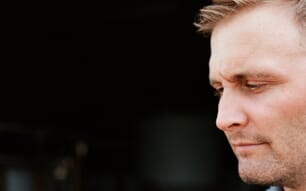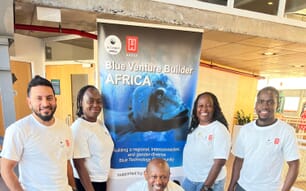Identity
Psetta maxima (Linnaeus, 1758)
FAO Names: En - Turbot, Fr - Turbot, Es - Rodaballo
Biological Features
Flatfish with asymmetric and almost round body (eyes on the left side). Scaleless skin but with bony protuberances irregularly distributed. Big mouth and small eyes. Dorsal and anal fins expand widely over the dorsal and ventral sides. Blind side (right) of whitish colour and eye side with variable colour, generally grey-brownish with dark spots.
Profile
Historical Background
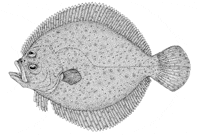
Turbot aquaculture commenced in the 1970s in scotland (uk). It was subsequently introduced to france and to spain. At first, the number of installations in spain was rather limited due to the scarcity of juveniles. The technological development of juvenile production changes this. At the beginning of the 1990s, there were already 16 producers in spain. A significant crisis in turbot culture occurred in 1992; there was an increase of 52 percent in production but the industry lacked a consolidated commercial marketing network.
Another factor that contributed to this crisis was that the farms were small and had very high production costs. This crisis caused the closure of some farms. From that moment onwards a reorganization of the sector began, which gave rise to a growth both in production and in the number of countries where turbot is farmed. Spain, with its highly suitable oceanographic conditions, is now the major producer worldwide but turbot is also currently farmed in denmark, germany, iceland, ireland, italy, norway, wales (uk), and portugal, and was previously reared in the netherlands. The natural distribution of the turbot includes coastal waters of all these countries. Turbot has also been introduced to other regions (notably chile in the late 1980s) and, more recently, china.
Besides commercial investment in improved facilities or the construction of new farms, other decisive factors have assisted in the consolidation and development of the sector. These have included the production of dry feeds and the development of vaccines for the most important diseases affecting turbot.
Main Producer Countries
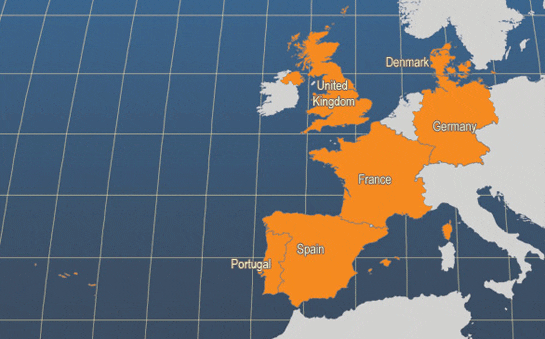
Habitat and Biology
Psetta maxima is a benthic marine species, living on sandy and muddy bottoms, from shallow waters to 100 m. Younger individuals tend to live in shallower areas. Cryptic, imitating the colour of the substrate. Carnivorous, juveniles feeding on molluscs and crustaceans, and adults mainly on fish and cephalopods. Spawning (sequenced, every 2-4 days) usually takes place between February and April inclusive in the Mediterranean, and between May and July inclusive in the Atlantic. Eggs have a single fat drop. Larvae are initially symmetric, but by the end of metamorphosis (day 40-50, 25 mm) the right eye has moved to the left, giving rise to asymmetry. Formerly known as Scophthalmus maximus.
Production
Production Cycle
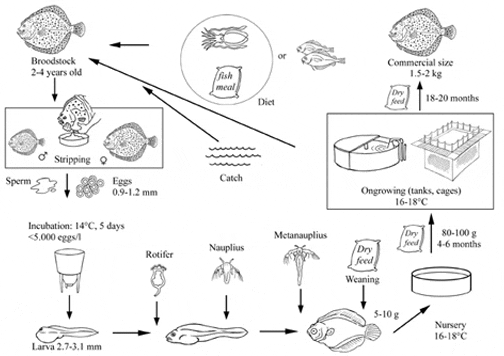
Production Systems
Seed Supply
Psetta maxima is a gonochoric species with separate sexes. Broodstock are maintained in square concrete or cement tanks, with volumes ranging from 20-40 m? At densities of 3-6 kg/m? And fed on moist pellets. The spawn are obtained by stripping. Females undergo ovulatory cycles with an approximate period of 70-90 hours. The eggs are pelagic and spherical in shape. Egg diameter varies between 0.9 mm and 1.2 mm. Embryonic development takes 60-70 days. After hatching, turbot larvae are 2.7-3.1 mm in length.
Hatchery Production
Larval culture may be semi-intensive or intensive. In semi-intensive systems, larvae are cultured at low density (2-5 larvae/litre) in a large volume (50 m?), while in intensive culture larval density is higher (15-20/litre) and tank volume is 20-30 m?. In both systems the rearing temperature is 18-20 ºC. The newly hatched larvae feed from their vitelline reserves; mouth opening occurs on day 3. Feeding is based on rotifers and Artemia. Phytoplankton is added to the culture medium. Weaning is in round-cornered square tanks with open-circuit pumped seawater. Various commercial feeds are used at the weaning stage.
Nursery
Turbot are nursed in square or circular tanks (10-30 m?) with open-circuit pumped seawater. Aeration systems are usually used to maintain the water at oxygen saturation. Juveniles are fed with dry pelleted feed, introduced manually or automatically. The weight range varies between 5-10 g and 80-100 g during the pre-fattening period (duration 4-6 months).
Ongrowing Techniques
Turbot are either reared in on-shore tanks (the most common technique for this species) or flat-bottomed cages.
Onshore tanks
Square or circular cement tanks (25-100 m?) are used, with open-circuit pumped seawater. Aeration or oxygenation systems are normally used to maintain the water at oxygen saturation. Feeding consists of extruded pellets, introduced manually or automatically. The elements that determine productivity are temperature and fry quality. The optimum temperatures for feeding range from 14-18ºC, while the extreme range for the culture of turbot is 11-23ºC. The limiting factors are pathology, culture technology and the market.
Cages
Cages submerged at various levels, or floating cages, in both cases flat-bottomed, are used. The frames are metal, with a metal or netting bottom. Extruded pelleted feeds are manually fed. The elements that determine productivity are suitable location and water temperature, and fry quality.
Feed Supply
Commercial turbot feeds are available, with a current (2003) cost of EUR 900/tonnes. Typical FCR is 1.1-1.2:1.
Harvesting Techniques
Fish are harvested manually and killed by placing them into containers filled with ice and seawater and transported to processing units.
Handling and Processing
Harvested fish are packed in polystyrene boxes, covered with a layer of ice and plastic film. In spain, turbot are generally marketed whole and fresh, while in the rest of europe they are generally gutted before sale. Spain has begun to produce filleted turbot to satisfy other european market demand. Size demand has changed. Formerly it ranged 1.5-2.0 kg but now smaller sizes are acceptable; currently sales range between 0.7 kg and 2.0 kg.
Production Costs
The ongrowing production cost is about eur 5-6/kg in tanks and eur 5/kg in cages. Despite the higher costs of on-shore tank culture, this remains the norm because cage culture of this species is still experimental stage and there are few locations that meet the optimum conditions for on-growing.
Diseases and Control Measures
| Disease | Agent | Type | Syndrome | Measures |
|---|---|---|---|---|
| Amoebic Gill Disease (AGD) | Neoparamoeba pemaquidensis | Ectoparasite | Gill parasitism; respiratory impairment | Freshwater bath |
| Trichodiniasis | Trichodina spp. | Ectoparasite | Flashing; skin darkening; lethargy; breathing difficulties; rubbing gill cover & body against rearing surfaces | Disinfectant bath |
| Scuticociliatosis | Philasteridis dicentrarchi | Ecto, Endoparasite | Cutaneous ulcers; darkened skin; swimming behaviour alterations; bulging eyes; abdominal distension | Density reduction |
| Microsporidiosis | Tetramicra brevifilum | Endoparasite | Density reduction | |
| Myxosporidiosis | Enteromysum scophthalmi | Endoparasite | Numerous white cysts on the skin and gills | Density reduction; complete disinfection of facilities |
| Flexibacteriosis | Tenacibaculum maritimun | Bacterium | Grey patches in dorsal fin area at first; lesions in head and mouth; sometimes gill rot | Vaccine; antibiotics |
| Furunculosis | Aeromonas salmonicida | Bacterium | Boil-like skin lesions | Antibiotics; farm-made vaccines |
| Streptococcosis | streptococcus parauberis | Bacterium | Haemorrhaging of fins, skin, and serosal surfaces; ulcers | Vaccine |
| Vibriosis | Vibrio anguillarum | Bacterium | Darkened skin; lethargy; frayed fins; skin ulcers; exophthalmia | Vaccine; antibiotics |
| A table constructed by peel and doye (2008) is presented to illustrate the relationship between bcs, market classifications and carcass characteristics for young beef cows (table 1). | ||||
Suppliers of pathology expertise
Expertise in pathology can be obtained from:
- Juan Luis Barja Pérez, Alicia Estévez Toranzo & Carlos Pereira Dopazo, Instituto de Acuicultura, University of Santiago de Compostela.
- Carlos Zarza, Servicio de Patología Skretting España.
- Frances Padrós. Servicio de Diagnóstico Patológico en Peces. Universidad Autónoma de Barcelona.
Statistics
Production Statistics

(FAO Fishery Statistic)
French production rose from an estimated 150 tonnes in 1993 to a peak of 980 tonnes in 1997; since then it has fluctuated, being 728 tonnes in 2002. In Portugal productions seems to be fluctuating around 350-390 tonnes/yr. By far the largest producer is Spain, whose annual production has nearly doubled since 1998. In 2002, Spanish turbot production was 3847 tonnes (75.9 percent of the global total). Besides the three countries mentioned above, no other country reported production above 50 tonnes in 2002.
The global production of turbot in 2002 was valued at USD 41.38 million.
Market and Trade
Most farmed turbot is currently consumed in the producing countries. In Spain, about 75 percent of production is consumed internally; the rest is exported to France, Italy and Germany. The product is generally sold fresh and whole, though in France a small proportion of the production is sold gutted. The European turbot market has no specific regulations, and there are no limits on trade within EU countries, no minimum sizes, and no withdrawal price.
Status and Trends
Turbot aquaculture can currently be considered a mature technology. It seems likely that the industry will see marked expansion in the future, with the construction of new rearing units and augmentation of the capacity of existing farms. Nevertheless, continued research and development effort is required in the following areas:
- Fry production, with the aim of increasing larval survival rates.
- Improved culture systems and automation.
- Disease prevention and control.
- Stock monitoring and genetic improvement.
- Improved marketing, with the consolidation of existing markets and development of new markets; avenues for processing need to be explored.
- Training for technical personnel with combined skills in aquaculture technology and business management.
Main Issues
The sector is evolving and is consolidated on-shore; culture in cages is just beginning and is considered to be in its pilot stage.
Responsible Aquaculture Practices
The farming of turbot is renowned for its responsibility. Most companies have implemented isp 14001, and some fulfil the emas ii system of the eu. No impact on the environment has been detected in studies on the on-shore aquaculture of turbot. The principles of the fao code of conduct for responsible fisheries should be adhered to.
August 2010



